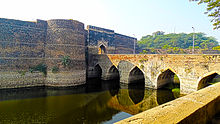Suraj Mal

Maharaja Suraj Mal (born February 13, 1707, † December 25, 1763 near Delhi ) was the most important historical representative of the ethnic group of Jats in northwest India .
biography
Suraj Mal was the son of Badan Singh (ruled 1722–1756), the founder of the independent princely state of Bharatpur . Traditionally, all Indian maharajas are assigned to the warrior caste ( kshatriyas ), but many jats rejected the caste system because they immigrated and were therefore casteless. In 1722 Badan Singh founded the Fort and Palace of Deeg , but transferred further construction activities to his son Suraj Mal, the builder of the Kumher Fortress and Lohagarh Fort in Bharatpur . He increasingly took on military tasks in which he had to deal with both the Mughals and the Marathas , and since Deeg was too close to Agra , one of the capitals of the Mughal empire, he moved the capital of his small empire in 1743 to Bharatpur further southeast. Three years later he won a victory against the Mughal army at the Battle of Chandaus.
In the controversy for the throne after the death of his fatherly friend Sawai Jai Singh II of Jaipur in 1743, he sided with his eldest son Ishwari Singh. In 1748 the conflict over the succession to the throne culminated in the three-day battle of Bagru, in which units of the Mughal army also took part; In the end, Suraj Mal emerged as the winner again. Further armed conflicts with the increasingly weaker Mughal empire followed and so Suraj Mal was even able to take its capital Delhi in May 1753 . The following year, the Marathas attacked Kumher Fortress, but could not take it - the whole thing ended with a peace treaty. Further conflicts between the local powers followed; in 1761 Suraj Mal could take Agra, which remained under the control of Bharatpur until 1774.
In 1763 Suraj Mal handed over part of his power and his military duties to his sons Jawarhar Singh and Nahar Singh , who however proved to be less competent. So Suraj Mal decided to intervene himself and in December 1763 captured the city of Farukh Nagar at the gates of Delhi, but on December 25th he was killed in an ambush. His cenotaph is in Govardhan ( Uttar Pradesh ).
Culture
Suraj Mal was a patron of the arts. Many of the buildings in the palace of Deeg go back to him; the Lohagarh Fort in Bharatpur is one of the largest and best fortified forts in Rajasthan. Musicians and poets stayed at his court.
literature
- K. Natwar-Singh: Maharaja Suraj Mal, 1707-1763 - His Life and Times. Rupa & Co., New Delhi 2001, ISBN 81-7167-510-7
Web links
| personal data | |
|---|---|
| SURNAME | Suraj Mal |
| BRIEF DESCRIPTION | Maharaja of Bharatpur |
| DATE OF BIRTH | February 13, 1707 |
| DATE OF DEATH | December 25, 1763 |
| Place of death | near Delhi |
